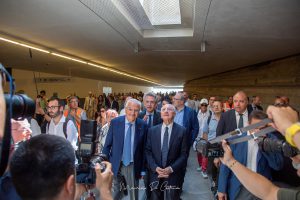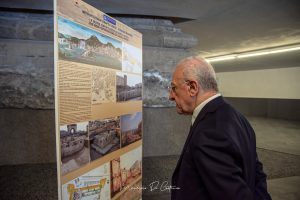
Big day for European tourism and public transportation in Naples.
Today, with the presence of Campania Region President Vincenzo De Luca, Naples Mayor Gaetano Manfredi, Councillor Edoardo Cosenza, Councillor Teresa Armato, City Council President Enza Amato, port authorities, Metropolitana di Napoli workers, and Eng. Vincenzo Orazzo for Anm, the direct passageway that takes tourists from the Port of Naples maritime station to the Municipio metro station was officially inaugurated.
The complex design of this work left everyone present at this event amazed.

President Vincenzo De Luca
With great pride, President De Luca said that on behalf of the Region a billion euros have been invested in the implementation of the project related to the Naples Metro Line 1.
His hope is that by 2024 we can see at least seven of the new trains in circulation, which are subject to complex verification and testing works.
In addition, according to the president’s words, the archaeological area surrounding the Municipio station site will also be fascinating, with the ancient Roman port being returned to the city and tourists.

Mayor Gaetano Manfredi
Joining the region’s president’s words, Naples Mayor Gaetano Manfredi claimed with satisfaction that this morning’s inauguration was possible thanks to the work done for a whole year by the City of Naples to streamline the timeframe for the procedures to deliver this passage to the city.
Finally, he said that next year the museum area will be inaugurated, and after that, within two years, it will be possible to go into the Maschio Angioino moat, which will enclose the remains of Roman civilization.

The Director of Metropolitan Lines, Eng. Vincenzo Orazzo
Important evidence in terms of tourism emerges from the words of the director of the metro lines, Eng. Vincenzo Orazzo, who argued that today’s inauguration allows the Naples metro to “land in the harbor,” just as it did in 2013 when the metro reached the high-speed line at Napoli Centrale.
In the near future, the subway will reach the Capodichino airport boarding, closing a cycle that allows the citizens of Naples, and especially tourists, to experience the city in a streamlined way and, above all, with zero environmental impact.

The city of Naples and its subway line are thus increasingly increasing their artistic and archaeological depth.
The work presented today is completely immersed in the Roman era and embraced on the side by the imposing Maschio Angioino, a work built in the 13th century at the behest of King Charles I of Anjou.
So, the underground connection, designed by Álvaro Siza and Edoardo Souto De Mura, capable of accommodating the entire users with the remains of the majestic Pier Tower, is equipped with treadmills, which will allow the crossing of the square without interfering with the surface road flow.
The Municipio station of the Naples metro line 1

The design of the Municipio Station was placed in the hands of Portuguese architects Álvaro Siza and Eduardo Souto de Moura, being inaugurated in 2015.
When work is officially completed, it will become an interchange between ANM Line 1 and Line 6 stations.
Mayor Manfredi’s forecast is to realize this node by no later than the middle of next year.
The surface urban planning arrangement enhances the perspective axis leading from the maritime station, with Vesuvius behind it, to the Town Hall building, to the hill of San Martino with the castel Sant’Elmo.

In the center of the square in front of the Naples City Hall is the marble group of the Fountain of Neptune, a work by Domenico Fontana Michelangelo Naccherino, Pietro Bernini and later Cosimo Fanzago.
The vast area, still under construction, will enhance the archaeological evidence coming to us from ancient Rome.

The complex archaeological museum that will come out of it will bring to light the ancient port of Neapolis, giving the vision of the ancient boats and the dock of the Augustan age.
Such history, then, will lead from the remains of ancient Rome to the Angevin era with the construction of Castel Nuovo, and will document the remains of the castle’s defense systems.
The common thread between the historical architecture and the modern works of Portuguese architects will be precisely the purity of lines and finishes in lava stone and white plaster, in whose geometries the lesson of the masters of the modern movement lives on.
Ph:Maurizio De Costanzo

